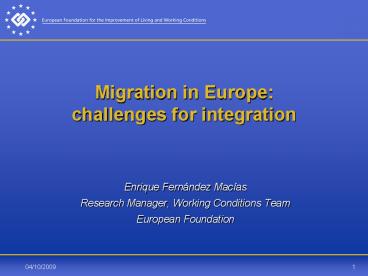Migration in Europe: challenges for integration - PowerPoint PPT Presentation
1 / 11
Title:
Migration in Europe: challenges for integration
Description:
With enlargement, migrants become mobile workers. ... With subsequent enlargements, the distinction between 'mobile workers' and ' ... – PowerPoint PPT presentation
Number of Views:61
Avg rating:3.0/5.0
Title: Migration in Europe: challenges for integration
1
Migration in Europechallenges for integration
- Enrique Fernández Macías
- Research Manager, Working Conditions Team
- European Foundation
2
Where do we come from
- For centuries, Europe was the main sender of
migrants in the world. - In 1950s, many European countries became
immigrant societies the booming economies of
North western Europe attracted many migrants from
Southern Europe and the Mediterranean. - The crisis of 1970s brought this trend to a halt
most governments became very restrictive,
although the previous migrants did not leave, of
course (many established with their families in
NW Europe). - In the eighties, migration was reduced, although
there were still flows due to family
reunifications and an increase in political
migration (asylum seekers). Integration started
becoming a big problem xenophobia increased in
many European countries. - In the nineties, migration increased again, but
the map changed completely most new migration
was directed to former sending countries, like
Spain or Ireland.
3
The impact of the European Union
- In respect to migration, the EU is a huge
historical achievement a (continuous)
enlargement of the freedom of movement of its
citizens. - Migration within EU is called mobility. Some
paradoxes here migration is a social problem
(with ever-higher barriers), mobility is a
strength (actively encouraged by institutions).
With enlargement, migrants become mobile workers. - In terms of regulation and law, the distinction
between migrants and mobile workers is relevant
in terms of integration, it is quite artificial
(increasingly, with enlargements). - The free movement within the EU means that there
is a drive for coordination, not very developed
until now but probably to be deepened
4
Migration in the EU in the last 20 years
5
Evolution of migration in four big countries
6
The current situation proportion
ofnon-nationals per country
7
The current situation EU migrants by country
(2005)
8
The future?
- Demographic projections show an ageing (and
eventual decline) of the EU population, what
might mean difficulties for the sustainability of
the social and economic system. More migration
will not solve the problem, but will certainly
help. - The success of the EU project means an increasing
pressure of illegal migration, specially in the
fringes (now South, very soon East). - With subsequent enlargements, the distinction
between mobile workers and migrants will
become even more artificial.
9
The integration of migrants in Europe challenges
ahead
- In some countries, migration has led to racism
and xenophobia. Specially when the economic
situation is difficult, migrants tend to become
scapegoats. - Previous waves of migration were not accompanied
by integration measures, as it was (wrongly)
assumed that it would be temporary (guest
workers). Current waves should have in-built
integration measures. - The main challenge will probably be illegal
migration, which very often has been the
unintended result of restrictive measures.
Illegal migration is very harmful for the
receiving societies and for the migrants
themselves. - Integration is not only a challenge for current
and future migration a lot has to be done still
regarding the integration of existing migrants
(including second and third generations)
10
Research by the Foundation
- Current projects
- Integration of migrants in European cities
- Geographic and labour market mobility in Europe
- Previous research
- Migration trends in an enlarged EU (2004)
- Migration and industrial relations in Europe
(2003) - Compendium of good practice for the prevention of
racism at the workplace (1997)
11
Thank you































